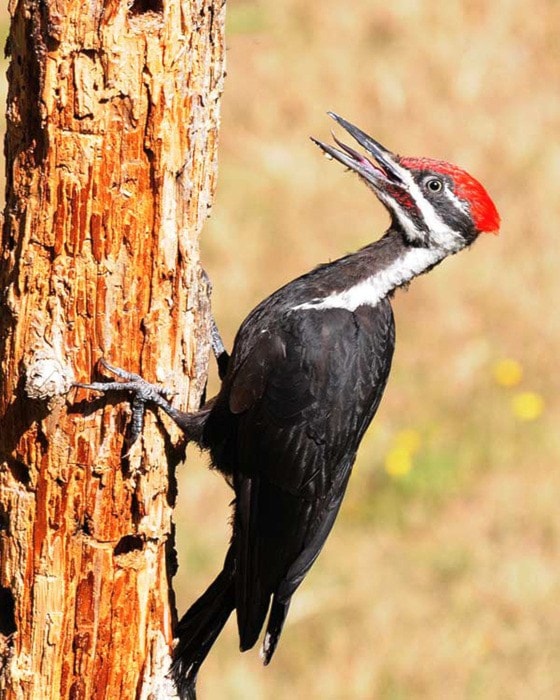One of the most charming and comical species of birds has to be the pileated woodpecker. Its unusual name is derived from the Latin word 'pileum' which described a pointed cap worn by the Romans and in fact resembled a crest. The pileated is the largest of the thirteen species of woodpeckers which also includes flickers and sap suckers. Locally the most common woodpeckers are the pileated, hairy and downy. Woodpeckers are very important 'keystone species' and critical to the safety and well being of many other wildlife species including, squirrels, owls, wood ducks, and many small songbirds that depend on them for nesting sites and food sources.
The pileated woodpecker is easily recognized by its distinct red head crest and is similar in size to a crow but has a longer and more slender beak. In addition to the red crest the male also has red markings at the base of the beak and a red moustache. Their bodies are mainly black with a white stripe running under the eyes and down the neck.
The silence of the forest is often broken by the loud drumming on a nearby tree, in the spring this can also be heard in urban areas as the woodpeckers announce their presence to a potential mate by drumming on a vent or roof top. In addition to the drumming they are also very vocal with the raucous nonstop chattering. These woodpeckers are found in densely forested areas that have a supply of dead or decaying trees where they excavate holes in search of food or to create a nest. The nests are only used by the woodpecker once then they abandon them at which point they become home to many other wildlife species providing a sanctuary or nest site. Locally, these woodpeckers are important to our smaller owls especially the northern pygmy, saw-whet and western screech owls providing them with cavity nests.
Woodpeckers are equipped with long chisel-shaped beaks with special features which allows them to hammer away at a tree. When watching a woodpecker at work one wonders how its head can take so much pounding; they have extremely thick skull bones that are designed to absorb the shock. Pileated woodpeckers excavate large oblong or square holes in contrast to flickers that are round and sapsuckers that drill a ring of small round holes that circle the tree trunk which eventually weaken or kill the tree.
All woodpecker species have unique tongues unlike any other birds; most birds have tongues that are anchored to the base of the skull and controlled by muscles. The woodpeckers tongue is extremely long and wraps up and over the eye sockets and anchors at the base of the beak allowing the tongue to stick out beyond the beak and recoil back, this allows the bird to stick out its tongue and probe deeply into a hole to catch its prey.
The actual surface of the tongues are also unique, flickers secrete sticky saliva that coats the tongue sticking the insects to the tongue, sap suckers have fine soft bristles which allow them to lap up the oozing sap, and woodpeckers have backward facing barbs which pull and spear insects from the holes or under bark. Pileated woodpeckers have short legs and strong curved claws which are designed for clinging and climbing up or down trees; a stiff, fanned tail helps stabilize them when they are excavating or probing for food. A variety of ants are the favourite food for woodpeckers, but they will eat other insects and some species survive on acorns and berries.
Last week M.A.R.S. rescued five newly hatched woodpeckers from a school yard in Comox, when a tree was removed that happened to be a wildlife tree. Wildlife trees and the area surrounding them are protected by law providing protection and conservation of wildlife habitat. For more information go to www.wildlifetree.ca and further check the reference to the wildlife act section 34.
The five baby woodpeckers had to be hand warmed by volunteers until their incubator was ready. Holding one of the babies I couldn't believe how ugly they were and how beautiful they become as adults. Unfortunately, all five babies died; they were just too cold when first brought in and were very difficult to feed.
We cannot emphasize strongly enough to respect wildlife habitat especially nest trees; please check a tree carefully before removing it and look and listen for any signs that wildlife is in residence.
To report injured or orphaned wildlife please call 250-337-2021 or visit our website at www.wingtips.org.
Sandy Fairfield is the educational co-ordinator for the Mountainaire Avian Rescue Society (MARS). The MARS column appears every second Thursday.
